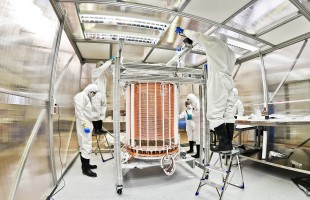The two major competing experiments that have so far hunted for dark-matter particles are joining forces for the next step. This week, US-based LUX-ZEPLIN and European XENON are publishing a joint memorandum of understanding.
The agreement gives new impetus to plans already in place for DARWIN, a larger detector for dark-matter particles, known as WIMPs. That project would use 40-50 tons of liquid xenon to find dark-matter collisions. LUX-ZEPLIN (LZ) and XENON both use several tons of xenon.
Dark matter makes up about 85 percent of all matter in the universe, but what it consists of is a mystery. Experiments like XENON in Gran Sasso and LZ in the U.S. have so far found no particles, and only provide limits on the properties of any dark-matter particles.
The new detector could take shape sometime after 2027, says Patrick Decowski of Nikhef’s Dark Matter group in Amsterdam. He is one of the signatories of the agreement, along with his colleagues Auke-Pieter Colijn and Tina Pollmann. Where the currently unnamed new detector will be built has not yet been decided.
In xenon detectors for dark matter, sensors around the xenon volume search for flashes of light and electrons released when an unknown particle collides with a heavy xenon atom. The detectors are deep underground to avoid interference from other cosmic rays; XENON is located in Italy under a kilometer of granite from Mount Gran Sasso.
The 40-50 tons of liquid xenon in the new detector is calculated to give ten times more sensitivity to dark matter. LZ and XENON did not find dark matter so far, but were able to set limits on the properties of WIMPs. The new detector is the next step in the search, says Decowski.
In addition to dark matter, the detector can be used to look at other rare physical processes. For example, it will look for axions from the sun, particles that could theoretically exist but have never been observed. In addition, neutrinoless double-beta decay, which would indicate new physics, is also on the program. DARWIN will also be able to observe neutrinos from the sun and supernovas.
In recent years, the xenon detector at Gran Sasso has been expanded from 3.5 to 8.5 tons of liquid xenon with great effort from Nikhef. The new XENONnT detector is expected to return to service this year for the hunt for dark matter particles. The instrument provided the sharpest limits yet on the properties of such WIMPs.
